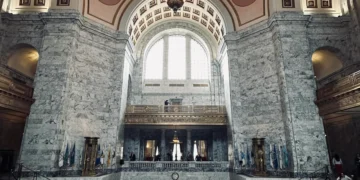Dec 12, 2024 Story by: Editor
Five years after becoming the first municipality in the United States to pass a reparations ordinance addressing historic discrimination against African Americans, Evanston commemorated the milestone on Dec. 5 with a dinner and town hall discussion. The city and its partners celebrated the ordinance’s anniversary, which has distributed $5 million since its inception.
Approximately 150 attendees gathered at Second Baptist Church, located at 1717 Benson Avenue, Evanston, to honor the achievements of the reparations program. The event featured local leaders, program recipients, and speakers from states including Maryland, California, and Oklahoma, where reparations initiatives are underway.
The ordinance, spearheaded by former Evanston City Council Member and current chair of the Reparations Committee Robin Rue Simmons, was created to rectify the discriminatory housing practices in Evanston from 1919 to 1969. These practices, which included racial covenants and redlining, caused significant harm to African American residents.
“The harm was state and corporate action within the city of Evanston,” said Cook County Circuit Judge Lionel Jean-Baptiste, who moderated the panel discussion. “Therefore, it was correct for the state to remediate.”
The program is funded by a 3% tax on cannabis sales and a real estate transfer tax on properties sold for over $1.5 million. The ordinance defines eligible recipients as Black residents who lived in Evanston during the specified period, referred to as ancestors, and their descendants. So far, 212 participants have received benefits, including $25,000 checks, assistance with home down payments, or support for home repairs and upgrades.
Addressing the Harm
Iva Carruthers, professor emeritus at Northeastern Illinois University, recounted her family’s journey to Evanston in 1919, fleeing a massacre in Arkansas. “The harm, however, is transgenerational. It is deadly and it is real,” Carruthers emphasized.
Karli Butler, a fourth-generation Evanston resident from the historically Black Fifth Ward, shared her family’s experience with the program. Her great-grandfather, Sam Butler, arrived in Evanston during the Great Migration. Butler partnered with her grandfather, James Edward Butler, a World War II veteran, to apply for the reparations program. Tragically, he passed away before completing the application process.
“I wanted my grandfather to get, someday, anything, and unfortunately, he didn’t get to see it. But I was fortunate to be able to go to the city and then have that $25,000 go to his heirs,” she said.
Lessons from Palm Springs and Tulsa
In November, Palm Springs announced a $5.9 million settlement for Black and Latino families displaced from the city in the 1960s. Attorney Areva Martin, who represents over 300 plaintiffs and their descendants, spoke about this case. “It wasn’t until the death of George Floyd in March of 2020 that the sense of urgency gave way to the advocacy that led us to where we are today,” Martin said.
Tulsa, Oklahoma, another city reckoning with historic racial violence, created a commission in August to recommend reparations for descendants of victims of the 1921 Tulsa Race Massacre. Tulsa City Council Member Vanessa Hall-Harper, who spoke at the panel, detailed the long and challenging process behind this effort.
“I’ll just say that in Tulsa, and I think in this country, but certainly in Tulsa, whenever there’s an attempt to do anything for and by Black people, there is an automatic pushback,” Hall-Harper remarked. “At the end of the day, the white institutions and the white power will never tell our history truthfully, and so we always have to be working to establish our own institutions for us, by us.”
Reflecting on Progress
In her closing remarks, Robin Rue Simmons highlighted Evanston’s ongoing work with the Road to Reparations exhibit at the Evanston Public Library, running from Dec. 3 to Jan. 31. “I didn’t get to name it yet; I’ve been really busy. But consider it My Faith, My Family and My Community. That’s what it’s named,” she said.
Rue Simmons also expressed gratitude to the community that made the reparations ordinance possible. “We had an interfaith community. We had allies, folks that didn’t look like us, that didn’t live in our neighborhood, but cared enough about our values to be uncomfortable and expose themselves and our city and do the hard work,” she said.
“That’s what we did. And so I love my community, and I want you to know that it is my community—it is Evanston that did this.” Source: Chicago Tribune
















